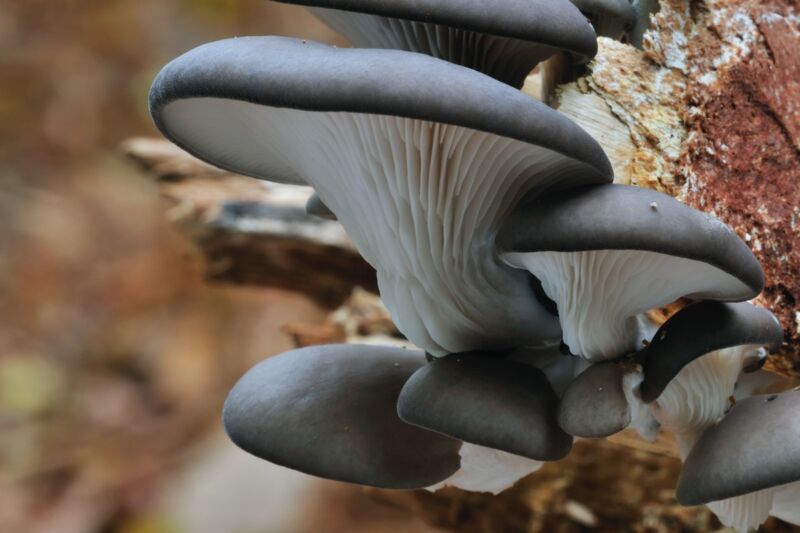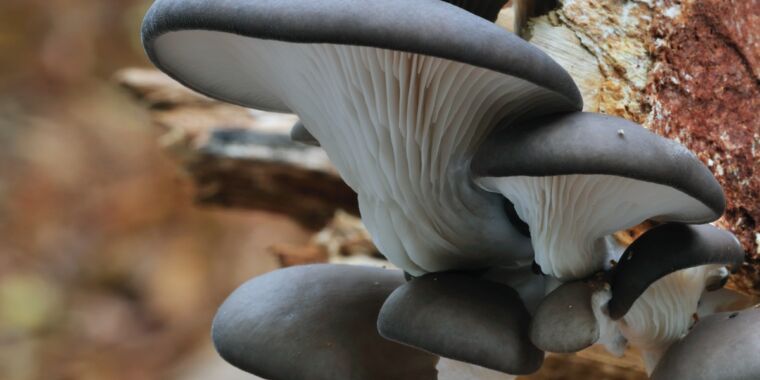
Arterra/Getty Images
oyster mushrooms (Pleurotus ostreatuslisten)) are a staple of many types of dishes, valued for its mild flavors and a scent vaguely reminiscent of aniseed. These cream-colored mushrooms are also one of several species of carnivorous fungi that specifically prey on nematodes (roundworms). The mushrooms have evolved a new mechanism for paralyzing and killing their nematode prey: a toxin contained in lollipop-like structures called toxocysts that, when expelled, causes widespread cell death in roundworms within minutes. Scientists have now identified the specific volatile organic compound responsible for this effect, according to a new paper published in the journal Science Advances.
Carnivorous fungi such as the oyster mushroom feed on nematodes because these critters are abundant in soil and provide a convenient source of protein. Different species have evolved different mechanisms to hunt and consume their prey. For example, oomycetes are fungus-like organisms that send out “hunter cells” to search for nematodes. Once they find them, they form cysts near the roundworms’ mouth or anus and inject themselves into the worms to attack the internal organs. Another group of oomycetes uses cells that act like prey-seeking harpoons, injecting the fungal spores into the worm to seal its fate.
Other fungi produce spores with irritating shapes such as spines or stilettos. The nematodes swallow the spores, which pass into the esophagus and germinate by piercing the worm’s gut. There are sticky twig-like structures that act like super glue; death collars that come off when nematodes swim through and inject themselves into the worms; and a dozen fungal species use snares that contract in less than a second and squeeze the nematodes to death.
Yi Yun Lee
The oyster mushroom avoids these physical traps in favor of a chemical mechanism. P. ostreatus is what is known as a “wood rotter” that targets dead trees, but wood is relatively low in protein. The long branching filaments (called hyphae) are the part of the magic mushroom that grows in the decaying wood. Those hyphae are home to the toxocysts. When nematodes encounter the toxocysts, they burst open and the nematodes usually become paralyzed and die within minutes. Once the prey is dead, the hyphae grow inside the nematode bodies, dissolve the contents and absorb the slurry for the nutrients.
In 2020, a team of scientists from Academia Sinica in Taiwan tested all 15 species P. ostreatus and discovered that all 15 could produce toxic droplets when starved. They also tested 17 species of nematodes and found that none could survive exposure to the toxin. Co-author Ching-Han Lee and colleagues suggested that the culprit could be the calcium stored in the muscles of animals, which, when released in response to nerve signals, causes muscles to contract. The muscles relax when nerve signals trigger the refilling of the calcium stores.
To test the hypothesis, the team performed experiments that showed the calcium in the worms, then monitored the response to exposure to the oyster mushroom toxocysts. They found that the pharyngeal and head muscles of poisoned nematodes were flooded with calcium and said calcium didn’t leave, leading to widespread nerve and muscle cell death. They suggested that the toxin triggers the initial calcium response, but then blocks the mechanism by which the nematodes restore their calcium stores.
A mitochondrial calcium wave that propagates through the hypodermic tissue upon contact P. ostreatus.Credit: Ching-Han Lee
But Lee et al. could not identify the specific toxins responsible for the effect, although they did note that the oyster mushroom’s chemical mechanism differs from the nematicides currently used to control nematode populations. For the new study, Lee and co-authors used gas chromatography mass spectrometry to do just that. The first version of the experiment tested a vial sample containing only the culture medium and glass beads. A second version tested a sample vial P. ostreatus cultured for two to three weeks. The third version was a combination of the first two, testing a vial sample containing both cultured P. ostreatus and glass beads.
The culprit: a volatile ketone called 3-octanone, one of several naturally occurring volatile organic compounds (VOCs) that fungi use for communication. It appears that 3-octanone also serves as a potent nematode-killing mechanism. Exposing four species of nematodes to 3-octanone caused the telltale massive (and deadly) influx of calcium ions into nerve and muscle cells. According to the authors, the dosage is of crucial importance. Low doses are a slug and snail repellent, but high doses are deadly. The same goes for nematodes. A high concentration of more than 50 percent 3-octanone is needed to cause rapid paralysis and widespread cell death. The team also caused thousands of random genetic mutations in the fungus. Those mutants that did not develop toxocysts on their hyphae were no longer toxic to the nematode Caenorhabditis elegans.
As for why oyster mushrooms have evolved such an unusual mechanism to kill nematodes, the authors suggest it is because dying or decaying trees are particularly poor in nitrogen, and this mechanism is a good way for the mushrooms to make up for that deficiency. to fill. The toxocysts may even serve a defensive purpose. Specific species of nematodes can pierce the hyphae to suck out the cytoplasm, so having toxocysts that emit poison gas on the hyphae could protect the fungus from such predators.
DOI: Science Advances, 2023. 10.1126/sciadv.ade4809 (About DOIs).

